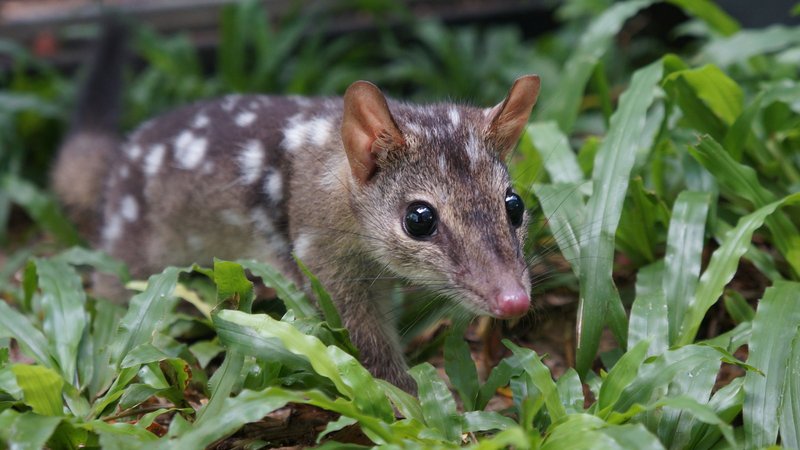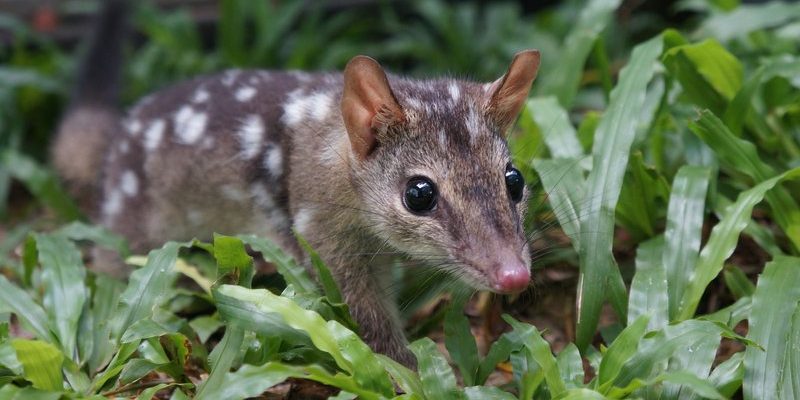
When you hear the word “quoll,” you might picture a cuddly creature, but these small marsupials are more like tiny, spotted tigers of the forest. Found mainly in Australia and New Guinea, quolls are fascinating animals that live different lives in the wild. They’re not only adorable with their distinct spots, but they also play an essential role in their ecosystems. If you’ve ever been curious about what makes quolls so unique, you’re in for a treat!
Imagine seeing a creature that looks like a mix between a cat and a possum, gliding through the trees and hunting for its next meal under the moonlight. That’s a quoll for you! These nocturnal hunters are agile and resourceful, adapting well to various habitats. Join me as we dive deep into the world of quolls, exploring their behavior, diet, habitats, and much more.
What is a Quoll?
A quoll is a small carnivorous marsupial that belongs to the family Dasyuridae. There are four species of quolls: the Eastern, Western, Northern, and the Spotted-tailed quoll. Each has distinct features but shares common characteristics that make them intriguing. Typically, quolls have a sleek body covered in short, coarse fur with white spots, giving them a some-what “spotted leopard” appearance. They’re about the size of a domestic cat, making them perfectly adorable in their natural environment.
At night, quolls become active hunters, using their keen sense of smell to track down prey. They are opportunistic feeders, which means they’ll eat whatever they can catch. From insects and small mammals to birds and even reptiles, quolls have a diverse palate. This adaptability allows them to thrive in various environments, whether it be rainforests, woodlands, or rocky terrains.
Physical Characteristics
Quolls are generally small but pack a punch in terms of personality and strength. Their size can range from about 24 to 75 cm long, depending on the species, and they weigh anywhere from 1 to 5 kg. The fur color varies — Eastern quolls are typically brown or grey with white spots, while Spotted-tailed quolls boast more of a darker hue with large white spots. A striking feature that sets them apart from other marsupials is their long, pointed snouts and sharp claws, which are perfect for climbing and digging.
Speaking of size, quolls possess a robust build with strong limbs, allowing them to leap between trees and navigate the forest floor effortlessly. Their ears are large and rounded, enhancing their ability to hear potential prey or predators. It’s fascinating how these characteristics not only contribute to their survival but also define them as unique creatures in the animal kingdom.
Habitat and Distribution
You might wonder where quolls call home. These remarkable marsupials are primarily found in Australia and New Guinea, inhabiting various ecosystems from lush rainforests to arid woodlands. They adapt to their surroundings, utilizing tree hollows and dense vegetation for shelter. Australian quolls are often seen in areas with plenty of cover, as they prefer to stay hidden from larger predators.
As habitat loss threatens their populations, the quoll’s range has shrunk in many regions. The Eastern quoll, for example, was once found throughout Southeastern Australia but is now limited to Tasmania. Habitat destruction from urban development and land clearing has posed significant challenges for these animals. Conservation efforts are underway to protect their remaining habitats and ensure that quolls continue to thrive in their natural environments.
Diet and Hunting Behavior
Quolls are true carnivores, hunting at night for a variety of foods. Their diet consists of small mammals, birds, insects, and even reptiles. They have strong hunting instincts and rely on their keen sense of smell and sharp claws to catch their prey. Sometimes their hunting strategy resembles a cat’s, as they stalk quietly before pouncing on unsuspecting animals.
In addition to their impressive hunting skills, quolls are opportunistic feeders. This means they’ll adapt their diet based on what’s available in their environment. If small mammals are scarce, they might turn to insects or fruits. This flexibility is crucial for their survival, especially in changing habitats. It’s quite fascinating to think about how adaptable they are, navigating their world with both skill and smarts!
Reproduction and Lifespan
Quolls have a unique reproductive cycle. Female quolls typically give birth to a litter of 4 to 6 young after a gestation period of about 3 weeks. Like other marsupials, the young are born extremely underdeveloped and crawl into their mother’s pouch to continue developing for several weeks. As they grow, they gradually transition to a more independent lifestyle, leaving the pouch after about two months.
The lifespan of quolls in the wild is generally around 2 to 4 years, but they can live longer in captivity. Unfortunately, their time in the wild is often cut short due to predation, habitat loss, and diseases. Female quolls only breed once a year, which can limit population growth in areas where their numbers are already declining. This makes conservation efforts even more critical in ensuring these charming animals continue to thrive.
Conservation Status
Sadly, quolls face numerous threats that have led to declining populations, particularly for the Eastern quoll. Habitat loss remains one of the most significant challenges they face, as urban development and land clearing rob them of their homes. Additionally, introduced predators like cats and foxes pose a considerable threat to quolls, preying on these smaller marsupials and competing for food.
Conservation groups are working tirelessly to protect quolls and their habitats. Programs focused on habitat restoration, wildlife corridors, and education about responsible pet ownership help mitigate some of these threats. Conservation efforts also include breeding programs in captivity that aim to reintroduce quolls into their natural environments. By raising awareness and encouraging sustainable practices, we can help ensure that future generations have the opportunity to encounter these wonderful creatures.
Interesting Facts about Quolls
| Species | Eastern Quoll | Western Quoll | Northern Quoll | Spotted-tailed Quoll |
| Size | 24-36 cm | 30-38 cm | 23-30 cm | 50-75 cm |
| Weight | 1-2.5 kg | 1-3 kg | 0.5-1.5 kg | 3-5 kg |
| Habitat | Tasmania, Australia | Western Australia | North Queensland | New South Wales, Tasmania |
| Diet | Carnivorous | Carnivorous | Carnivorous | Carnivorous |
Myths and Misconceptions
With any unique animal, there are bound to be myths and misconceptions. One common myth is that all quolls are dangerous due to their sharp teeth and claws. In reality, while they are carnivorous hunters, they pose little threat to humans. In fact, they are quite shy and prefer to avoid contact.
Another misconception is about their reproductive habits. Some believe that quolls breed multiple times a year, but most species usually breed once annually. This limited breeding can make population recovery more challenging, especially when they face habitat threats. Understanding these aspects of their life helps us appreciate quolls even more and emphasizes the importance of protecting them.
Quolls in Popular Culture
Though not as famous as kangaroos or koalas, quolls have made their mark in popular culture. They have been featured in various documentaries, wildlife shows, and even children’s books. These portrayals often highlight their unique characteristics and roles in the ecosystem, educating the public about their importance and conservation.
In some regions, quolls have received affectionate nicknames, which further endears them to the public. As awareness campaigns grow, these little creatures are gaining more recognition, helping people understand the role they play in maintaining ecological balance. With increased visibility, conservation efforts will hopefully receive more support to ensure their survival.
Quolls are truly remarkable little creatures, showcasing the beauty and complexity of nature. From their varied diets and unique reproductive habits to their spots and playful behavior, there’s much more to these small marsupials than meets the eye. By learning about quolls, you’re contributing to the awareness and appreciation necessary to protect them for future generations.
So, the next time you find yourself in Australia or New Guinea, take a moment to think about these charming animals. Whether they’re lurking in the trees or hunting under the cover of night, quolls remind us of the biodiversity we need to cherish and protect. It’s up to us to spread the word and play our part in ensuring their survival!
FAQ
What do quolls eat?
Quolls are carnivorous mammals primarily feeding on small mammals, birds, insects, and reptiles. Their diet is quite varied, enabling them to adapt to whatever prey is available in their habitat. They rely on their keen sense of smell and agility to hunt, stalking quietly before pouncing on their unsuspecting dinner.
How do quolls breed?
Quolls have a unique breeding process where females give birth to 4 to 6 young after a relatively short gestation period of around 3 weeks. The tiny, underdeveloped young crawl into their mother’s pouch for protection and nourishment, staying there for several weeks as they grow. After leaving the pouch, they gradually learn to hunt and become more independent.
Are quolls endangered?
Quolls face numerous threats, leading to declines in their populations, particularly the Eastern quoll. Habitat loss due to human activities, alongside introduced predators like cats and foxes, has put these marsupials at risk. Conservation efforts are critical in protecting quoll habitats and supporting their populations.
Where can I find quolls?
Quolls are found primarily in Australia and New Guinea. Each quoll species has a distinct range: the Eastern quoll thrives in Tasmania, the Northern quoll in North Queensland, and more. They typically prefer habitats such as forests, woodlands, and rocky areas where they can find shelter and food.
Can quolls be kept as pets?
While quolls may seem adorable, they are wild animals with specific needs that cannot be met in a domestic setting. They require large territories, specialized diets, and social interactions with other quolls. Keeping them as pets is not advisable and is illegal in many places.
How fast can quolls run?
Quolls are agile creatures, capable of sprinting quickly when needed. While specific speeds are not documented, their physical build allows them to navigate trees and forests with remarkable agility, making them effective hunters despite their smaller size.
Do quolls have natural predators?
Yes, quolls face several natural predators, including larger birds, snakes, and even domestic cats. Their smaller size makes them vulnerable, especially when hunting or moving about during their active nighttime hours. This is why they rely on their stealth and agility to avoid detection.
What is the lifespan of a quoll in the wild?
In the wild, quolls typically live between 2 to 4 years. However, their lifespan can be longer in captivity, where they face fewer threats from predators, disease, and habitat loss. Their short lifespan underscores the challenges they face in the wild.
How can I help quolls?
You can aid quolls by supporting conservation organizations working to protect their habitats and educate the public about these animals. Staying informed about local wildlife and advocating for responsible land use also helps create a safer environment for quolls and other species.
Are quolls solitary animals?
Generally, quolls are solitary creatures, except during the breeding season. They establish territories and prefer to hunt and live alone. However, in some circumstances, quolls may share their habitat with others of their kind, especially if resources are plentiful.

